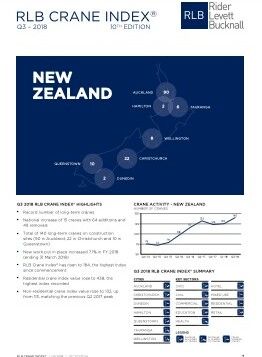The ongoing construction boom now has an unprecedented 140 long-term cranes across New Zealand’s cities, and 15 more (+12%) than the last count six months ago, according to the Rider Levett Bucknall Q3 2018 RLB Crane Index® released today.
The Tenth edition of the RLB Crane Index® highlights the strong growth within New Zealand’s construction industry. Since RLB’s last edition (Q1 2018), 64 new cranes were put in place and 49 cranes were removed.
Chris Haines, Director of RLB in Auckland said ‘The level of construction activity remains high across the country. Not only will the population and migration surge of recent years continue to support demand for construction across the residential sector, but significant demands remain on commercial, retail, health, education and horizontal infrastructure sectors.’
New Zealand’s new work put in place continued to grow for FY 2018, up 7.1% from FY 2017, totalling over $17 billion. The residential sector remained the most dominant sector, increasing 8.9% to $12 billion.
Auckland main driver of crane count
According to the RLB Crane Index®, Auckland continues to be the main driver of the crane count, contributing 64% to the total New Zealand count. Of the 140 cranes sighted across New Zealand, 90 were in Auckland (8.4% increase in 6 months), 22 in Christchurch (+69%), 10 in Queenstown, 8 in Wellington, 6 in Tauranga, 2 in Dunedin and 2 were in Hamilton.
Christchurch emerging from the bottom of its cycle
Chris continued, ‘Christchurch saw a significant jump to 22 cranes this edition, up from the previous 13 cranes. Christchurch’s crane count had consistently been dropping since 2015 in line with the decline in the city’s construction workload.’
‘In this edition however, there has been a net increase of 9 cranes (17 cranes newly erected over the past 6 months while 8 cranes were removed). Christchurch’s commercial and retail sectors have proved buoyant with 14 cranes in total and could indicate Christchurch is emerging up from the bottom of its cycle,’ he added.
Both Wellington and Tauranga experienced net decreases of one crane each, while Hamilton and Dunedin remained constant with two cranes each. After a slight dip in the last edition, Queenstown has seen an increase in crane numbers, reaching ten.
Residential index increases to a record high
There are now 57 long-term cranes on residential projects in the main centres. This sector includes both the busy aged care sector and student residential accommodation alongside the private residential sector in Auckland particularly.
Chris noted, ‘Despite the well-publicised resource capacity issues, the recent announcement of the Ebert receivership, coupled with Fletcher Construction’s withdrawal from the vertical construction market, Auckland’s crane count remains on the rise.’
Investment boom for bricks and mortar retail
According to the RLB Crane Index®, the ‘bricks and mortar’ retail sector appears to be under a current investment boom, which is reflected in the increase in retail cranes for both Auckland and Christchurch in particular. Auckland has seen a jump in retail cranes, with four cranes at 277 Westfield in Newmarket, one at Kiwi Property’s Galleria expansion in Sylvia Park, and one at the Commercial Bay Mall.
The commercial sector remains strong, with significant continued investment from Precinct Properties in Auckland and Wellington, and from Manson’s in Auckland.
The health sector crane count has declined significantly, with only a single crane remaining at Christchurch Hospital.
Auckland continues to rise with 86% of residential cranes in New Zealand
Reflecting the buoyancy of the Auckland construction market, Auckland’s residential crane count remained high, accounting for 86% of all residential cranes in New Zealand and 35% of all cranes nationally. This includes cranes on projects for multi-residential apartments, private residential, student residential accommodation and the busy aged care sector. The impact of ‘KiwiBuild’ in terms of work put in place is not yet impacting the crane count but this may change into 2019.
Retail sector records largest growth
The retail sector recorded the largest growth, with six new cranes added at 277 Broadway Westfield Development (four cranes) and the Galleria expansion (one crane).
The civic and mixed used sectors saw a decrease of two and one crane respectively, while the education sector saw an increase of one crane. The civil and hotel sectors remained the same.
No cranes recorded on health projects
In the commercial sector, three cranes remained on site for the Commercial Bay office project. These are expected to stay in place until late 2019. Notably, there were no cranes recorded on health projects in Auckland currently despite significant forward workload planned in the health sector.
Despite the perception in the market that the construction sector is at capacity and resources are stretched, the crane numbers have again increased.
FURTHER INFORMATION:



